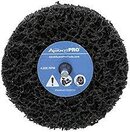I have one of the Vinyl coated tanks from USD. Mine is shiny steel inside, with no liner. The coating makes it impossible to read some of the numbers that are stamped into the tank, so I am looking for a good way to remove the coating so that I can get a fresh hydro test, unless someone want's to buy it as-is for collector value.I thought I would leverage this thread again instead of starting a new one for another LP72 identification question. Who made these tanks? And how would I tell if it has a liner inside?
I can't tell what the hydro mark is. Is it a circle with something inside of it (a D maybe?), or is it an outline of a C? In any case, the rest of the marks are:
ICC 3AA 2250
K64433
USD
9C67+
They are indeed US Divers tanks: I got a pair of them that were still attached to the "aqua-lung-pac" (why did USD put everything in quotes?!?) with J-valves and the pull levers still in place.
According to @captain it seems that the hydro mark might be a C over an L which would make it a PST? Ref: 1970 US Diver's LP72 - Lined or not?
The tanks are seemingly in nice condition. They seem to be vinyl-wrapped on the outside? I don't think it's paint, but it is quite intact. I'm guessing that it's the "Tuff Koate" that @Akimbo refers to in a 1970 catalog a couple of posts later in the above link.
One thing that is different from the 1970 description is that I'm pretty certain that these are *not* galvanized under the Tuff Koate. The couple of places that the outer liner is damaged shows brown-black metal, not galvanized metal. So they're probably not the exact same tanks as were sold in 1970.
I'm more worried about whether they have the epoxy liner or not. It seems that 1967 is right on the border of internal liner or not. The inside looks like a uniform brown-orange coating. I've seen tanks that looked like that when they were consistently exposed to wet fills; but I've never seen an epoxy liner before, and I understand that they're brown, too. I've got the tanks soaking with phosphoric acid right now, so we'll see what happens.
However, if it is liner, it seems intact. If they pass hydro, I'm using them as-is, and I get to keep the original stickers this time!
Thank you very much for any help you might be able to provide. I appreciate it.
At one time, I was able to identify the original manufacturer who made the tank for USD, but the name of that company has fallen out of my head since then. I'm pretty sure it wasn't PST. I think it was someone I was less familiar with. If you google around a bit, or search this forum some more, you may locate that information. It is out there somewhere. Also, USD may have used more than one supplier, so just because mine wasn't PST, doesn't necessarily mean that yours wasn't.
The first recertification date on my tank is 1977, so it would seem likely that the born on date would be 1972 or earlier. I can't actually read the original date, nor most of the other numbers/letters.




